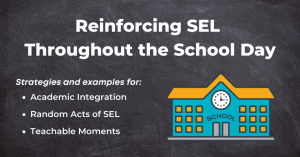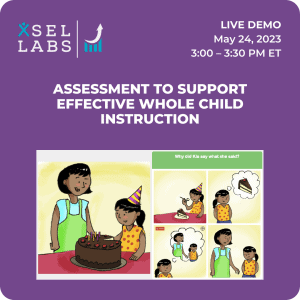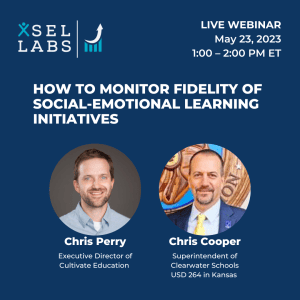Why Reinforce SEL Beyond Explicit Instruction?
Too often, the gap between SEL assessment data and action feels like the Grand Canyon. It is easy to imagine, for example, a grade-level team at an elementary school getting their SEL assessment data, thoroughly reviewing the numbers, and not knowing what to do from there. Maybe that has been your experience. Whatever the case, when this happens, the assessment data cannot possibly benefit teaching and learning.
We want educators to get the most out of their SEL assessment data. That means equipping our partners to bridge the gap between data and action. The gap is much smaller than the Grand Canyon. In our experience, once educators have a few ideas of how to use their data to guide action, they quickly come up with many more.
In my last blog post—Aligning SEL Assessment for Data-Informed Instruction—I shared some ideas about how to use SEL assessment data to guide explicit SEL instruction. Specifically, I discussed how program alignments illustrating the relationship between what an assessment measures and the targets of instruction can support decision-making about explicit instruction.
But SEL happens all day long, not just during explicit SEL instruction. And educators and others increasingly recognize that fostering student social and emotional development requires SEL practices throughout the school day. SEL assessment can help you do that in a focused way.
In this blog post, I am going to share a few ideas about how to use SEL assessment data to reinforce SEL practices beyond explicit SEL instruction and throughout the school day.
→ Download our Reinforcing SEL Skills Tip Sheet
Start with the SEL Competence that You Want to Reinforce
Teaching is a demanding profession, and teachers are expected to do many things and play many roles. In this context, integrating SEL with academic instruction and other activities may seem overwhelming. After all, SEL encompasses many, many competencies, so where to begin?
One way to proceed is to pick a single competence to support and focus on that competence throughout the day. And here is where SEL assessment can help. Imagine, for example, that you were a classroom teacher and had just received your fall SEL competency data. Imagine further that the assessment data suggested that social problem-solving was a particular area of need for your students.
Based on this assessment, you could choose to focus your efforts outside of SEL lessons on teaching social problem-solving, one of the CASEL Framework “Relationship Skills.” Do not worry about other competencies for now—just focus on this single competence.
Understand the SEL Competence You Are Trying to Teach
Now that you have selected a competence to reinforce throughout the day, the next step is clarifying what that competence is and how it expresses itself in daily life. For example, the chart below shows how the competencies measured by SELweb work and what they look like in everyday life.
| SELweb Competence | CASEL Framework Area | How It Works | Example |
| Emotion Recognition | Social Awareness | This involves “reading” body language, particularly facial expressions, to understand how otherfeelng. | A child sees someone crying and understands that the person feels sad. |
| Social Perspective-Taking | Social Awareness | This involves using situational cues to infer others’ thoughts and intentions. | A child sees that someone on the playground looks impatient and understands that person wants to have a turn to play. |
| Social Problem-Solving | Relationship Skills | This involves going through a series of steps to resolve problems:
|
Two children disagree about who should go first in a board game. The teacher coaches them to calm down, say what the problem, state their goals, come up with some ideas, think through the pros and cons, pick the best one, and put it into practice. |
| Self-Control | Self-Management | This involves using strategies to manage unwanted feelings and the situations that cause them. | A child is nervous about an upcoming test and tells herself, “When you work hard, you do well in school.” |
From the table above, social problem-solving involves these specific and teachable steps for dealing with problems:
- Stop and calm down.
- Say what the problem is.
- Generate alternative solutions.
- Evaluate the pros and cons of those solutions.
- Pick the best one.
Now that you have a firm grasp of what the competence involves, you are ready to integrate social problem-solving instruction into what you do throughout the day. Let’s talk about how.
Three Ways to Reinforce SEL Throughout the Day
Download our Reinforcing SEL Tip Sheet
1. Integrate SEL with Academics
Literacy and social studies provide frequent opportunities to reinforce SEL skills. Why? Let’s face it; almost every story contains a problem or series of problems, often between characters in the story. And social studies is nothing if not the study of conflicts through the ages. In that context, it is easy to imagine integrating SEL instruction.
For example, imagine you were a first-grade teacher, and it is story time. You are reading a story, and one character hurts another character’s feelings. You could probe this using a social problem-solving framework, asking questions like:
- What is the problem between these two characters?
- What are things they could do to solve the problem?
- Taking a couple of those solutions, ask, “What would happen next if they did that?”
- What do you think is the best thing to do to solve the problem?
Asking these questions does not take away from literacy—in fact, it advances literacy by prompting students to think deeply about the story. But it also gives them an opportunity to practice social problem-solving steps. In addition, from students’ answers, teachers can also continue to evaluate student progress in thinking wisely about social problems and their resolution.
By the way, it is possible to imagine questions during literacy instruction that would get at emotion recognition, social perspective-taking, and self-control. See if you can decide which question corresponds to which competence:
- What do you think the story character is feeling? How do you know?
- What could the story character do to feel better?
- Why did the story character do what she did?
Pick a competence, and it is possible to spontaneously ask questions that give students a chance to practice the specific competence that you want to work on.
2. Engage in Random Acts of SEL
Having selected a competence to focus on, it would be possible to give frequent one-minute spontaneous exercises on your competence of choice. You could, for example, find a photo or video online depicting everyday conflict. Show it to the class and go through the prompts from above. This does not take much time, gives students more opportunities to build SEL “muscles,” and gives you, the teacher, additional information about how your students are progressing.
3. Use Teachable Moments
The beautiful thing about SEL is that it is an “always on” part of human life. Whenever we are together, which is to say, all our waking hours, we are reading each other (sometimes well, sometimes poorly), sizing up and managing conflicts (big and small), and managing our emotions in response to the stresses and strains of the day (sometimes better than others). So, too, it is with children.
As a result, daily life, particularly in unstructured settings, provides many teachable moments. Conflict on the playground? Coach problem-solving. Heated disagreement during group work on a math problem? Walk the students through the problem-solving process. (Bonus if you ask each child what the other is thinking and feeling to practice emotion recognition and social perspective-taking). You get the idea.
Our Reinforcing SEL Skills Tip Sheet describes these strategies and how they can be used to reinforce SEL domains defined in the CASEL framework.
Just the Beginning
I am reasonably confident that the ideas I shared above can help any teacher integrate SEL practices throughout the school day. I am also confident that this is just the tip of the iceberg. After picking a competence and getting clear about what it is, I know from experience that a motivated team of educators can devise a dozen creative ways to reinforce the competencies measured by your assessment.
If you have other ideas about how to reinforce SEL during academic instruction throughout the school day, let me know. I always love hearing from others about how they have solved this important problem.




